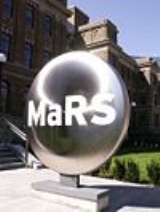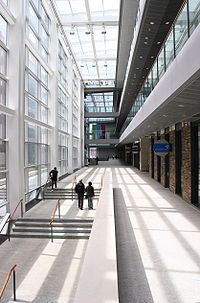
MaRS Discovery District
Encyclopedia
MaRS Discovery District is a not-for-profit corporation founded in Toronto
in 2000. Its stated goal is to commercialize publicly funded medical research with the help of local private enterprises and as such is a public-private partnership
.
The name MaRS was originally drawn from a file name, and later attributed with the title “Medical and Related Sciences.” As MaRS also works in other fields such as Information and Communications Technology, Engineering
, and Social Innovation
, it has since abandoned this association.
 It is located on the corner of College Street
It is located on the corner of College Street
and University Avenue
in the city of Toronto
’s Discovery District
, adjacent to the University of Toronto
and its affiliated research hospitals at the University Health Network
.
The MaRS development consists of two phases.
The Heritage Building
Inside the Heritage Building's four-storey brick façade (preserved) are tenant spaces occupied by professional services, industry associations, pharmaceutical companies and offices of Canadian universities and the Province of Ontario. In 2006, the MaRS Centre received the Heritage Toronto Award of Excellence for Architectural Conservation and Craftsmanship.
The Atrium
The MaRS atrium is a glass-roofed public thoroughfare that provides walkway access to Heritage Building tenants and retail vendors, as well as access to the South Tower and Medical Discovery Tower. Its bottom level features a sub-dividable conference area that hosts public and private events. MaRS encourages events from across Toronto's arts, culture and broader urban community. The Atrium's lower level also features media centre, videoconferening rooms and a public food court.
The South Tower
This 11-storey structure houses incubator programs and shared laboratory and research facilities. The 200000 square feet (18,580.6 m²), wet-lab-capable building spans eight floors in the MaRS Centre. The tower boasts advanced mechanical and electrical systems, floors with enhanced load bearing capabilities and 15 feet (4.6 m) slab-to-slab clearances.
Occupying the second and third floors of the South Tower—directly above the MaRS corporate offices, is the MaRS Incubator – a dedicated space that houses offices and laboratories for approximately two dozen life science and technology firms.
Toronto Medical Discovery Tower
With 400000 square feet (37,161.2 m²) of state-of-the-art wet labs, the 15-storey Toronto Medical Discovery Tower accommodates leading-edge scientific equipment and houses the basic research activities of two of Canada's premier research hospitals: the University Health Network and the Hospital for Sick Children.
Situated on the corner of College and Elizabeth Street, the building was designed with typical research and development lab floors configured with a side core arrangement and sheathed in metal and glass. The tower portions rest on a three-storey limestone podium that aligns with the heights of the adjoining College Wing and the formal landscape forecourt that extends the full block.
The shell and core of the TMDT is designed to accommodate a full lab program based on 80% wet lab and 20% dry lab. The lab floors have been configured to maximize future flexibility. The mechanical and electrical rooms, power and communication distribution systems, general and special exhaust risers, floor drains and service zones, have been established to allow for fit-out by future tenants.
Phase I began operations in 2005.
. Construction resumed in July 2011, with a target completion date of Fall 2013.
 In April 2010, criticism of the $471,874 salary collected by MaRS CEO Ilse Treurnicht in 2008 was raised It also criticized government-led funding, lack of accountability and rigor in measuring results, claims of public-private partnerships and the absence of visible-minorities among MaRS's team of advisors.
In April 2010, criticism of the $471,874 salary collected by MaRS CEO Ilse Treurnicht in 2008 was raised It also criticized government-led funding, lack of accountability and rigor in measuring results, claims of public-private partnerships and the absence of visible-minorities among MaRS's team of advisors.
On Aug. 27, 2010, the National Post
relayed some of these criticisms
Renewed criticism was published in 2011, pointing in particular to the $100,000 increase in salary of MaRS CEO, her $534,000 salary in 2010, and questioning the public and private funding of the phase 2 expansion. The Toronto Sun
published articles on the topic as well, questioning the high compensation levels at the institution.
Toronto
Toronto is the provincial capital of Ontario and the largest city in Canada. It is located in Southern Ontario on the northwestern shore of Lake Ontario. A relatively modern city, Toronto's history dates back to the late-18th century, when its land was first purchased by the British monarchy from...
in 2000. Its stated goal is to commercialize publicly funded medical research with the help of local private enterprises and as such is a public-private partnership
Public-private partnership
Public–private partnership describes a government service or private business venture which is funded and operated through a partnership of government and one or more private sector companies...
.
The name MaRS was originally drawn from a file name, and later attributed with the title “Medical and Related Sciences.” As MaRS also works in other fields such as Information and Communications Technology, Engineering
Engineering
Engineering is the discipline, art, skill and profession of acquiring and applying scientific, mathematical, economic, social, and practical knowledge, in order to design and build structures, machines, devices, systems, materials and processes that safely realize improvements to the lives of...
, and Social Innovation
Social innovation
Social innovation refers to new strategies, concepts, ideas and organizations that meet social needs of all kinds - from working conditions and education to community development and health - and that extend and strengthen civil society....
, it has since abandoned this association.
Facilities

College Street (Toronto)
College Street is a principal arterial thoroughfare in downtown Toronto, connecting former streetcar suburbs in the west with the city centre. The street is home to an ethnically diverse population in the western residential reaches, and institutions like the Ontario Legislature and the University...
and University Avenue
University Avenue (Toronto)
University Avenue is a major north-south road in Downtown Toronto, Ontario, Canada. At its north end, University Avenue is the site of the Ontario Legislative Building. The eight-lane wide street is the location for several hospitals, numerous office buildings, Osgoode Hall and the Four Seasons...
in the city of Toronto
Toronto
Toronto is the provincial capital of Ontario and the largest city in Canada. It is located in Southern Ontario on the northwestern shore of Lake Ontario. A relatively modern city, Toronto's history dates back to the late-18th century, when its land was first purchased by the British monarchy from...
’s Discovery District
Discovery District
The Discovery District is an area of downtown Toronto, Ontario, Canada, that features a high concentration of hospitals and research institutions, particularly those related to biotechnology...
, adjacent to the University of Toronto
University of Toronto
The University of Toronto is a public research university in Toronto, Ontario, Canada, situated on the grounds that surround Queen's Park. It was founded by royal charter in 1827 as King's College, the first institution of higher learning in Upper Canada...
and its affiliated research hospitals at the University Health Network
University Health Network
University Health Network is a medical centre that comprises three teaching hospitals affiliated with the University of Toronto Faculty of Medicine....
.
The MaRS development consists of two phases.
Phase I
MaRS Discovery District Phase I includes:- The Heritage Building (formerly a wing of the Toronto General HospitalToronto General HospitalThe Toronto General Hospital , is a part of the University Health Network, and a major teaching hospital in downtown Toronto, Ontario. It is located in the Discovery District, directly north of the Hospital for Sick Children, across Gerrard Street West, and east of Princess Margaret Hospital and...
), - The Atrium
- The South Tower
- The Toronto Medical Discovery Tower
The Heritage Building
Inside the Heritage Building's four-storey brick façade (preserved) are tenant spaces occupied by professional services, industry associations, pharmaceutical companies and offices of Canadian universities and the Province of Ontario. In 2006, the MaRS Centre received the Heritage Toronto Award of Excellence for Architectural Conservation and Craftsmanship.
The Atrium
The MaRS atrium is a glass-roofed public thoroughfare that provides walkway access to Heritage Building tenants and retail vendors, as well as access to the South Tower and Medical Discovery Tower. Its bottom level features a sub-dividable conference area that hosts public and private events. MaRS encourages events from across Toronto's arts, culture and broader urban community. The Atrium's lower level also features media centre, videoconferening rooms and a public food court.
The South Tower
This 11-storey structure houses incubator programs and shared laboratory and research facilities. The 200000 square feet (18,580.6 m²), wet-lab-capable building spans eight floors in the MaRS Centre. The tower boasts advanced mechanical and electrical systems, floors with enhanced load bearing capabilities and 15 feet (4.6 m) slab-to-slab clearances.
Occupying the second and third floors of the South Tower—directly above the MaRS corporate offices, is the MaRS Incubator – a dedicated space that houses offices and laboratories for approximately two dozen life science and technology firms.
Toronto Medical Discovery Tower
With 400000 square feet (37,161.2 m²) of state-of-the-art wet labs, the 15-storey Toronto Medical Discovery Tower accommodates leading-edge scientific equipment and houses the basic research activities of two of Canada's premier research hospitals: the University Health Network and the Hospital for Sick Children.
Situated on the corner of College and Elizabeth Street, the building was designed with typical research and development lab floors configured with a side core arrangement and sheathed in metal and glass. The tower portions rest on a three-storey limestone podium that aligns with the heights of the adjoining College Wing and the formal landscape forecourt that extends the full block.
The shell and core of the TMDT is designed to accommodate a full lab program based on 80% wet lab and 20% dry lab. The lab floors have been configured to maximize future flexibility. The mechanical and electrical rooms, power and communication distribution systems, general and special exhaust risers, floor drains and service zones, have been established to allow for fit-out by future tenants.
Phase I began operations in 2005.
Phase II
Phase II, designed by Bregman + Hamann Architects, will constitute a 800000 square feet (74,322.4 m²) addition to the MaRS centre in the form of a 20-story tower on the complex’s west wing. Construction began in late 2007, and was scheduled to be completed in spring 2010. In November 2008, Phase II construction was put on hold due to the economic downturnLate 2000s recession
The late-2000s recession, sometimes referred to as the Great Recession or Lesser Depression or Long Recession, is a severe ongoing global economic problem that began in December 2007 and took a particularly sharp downward turn in September 2008. The Great Recession has affected the entire world...
. Construction resumed in July 2011, with a target completion date of Fall 2013.
Criticism

On Aug. 27, 2010, the National Post
National Post
The National Post is a Canadian English-language national newspaper based in Don Mills, a district of Toronto. The paper is owned by Postmedia Network Inc. and is published Mondays through Saturdays...
relayed some of these criticisms
Renewed criticism was published in 2011, pointing in particular to the $100,000 increase in salary of MaRS CEO, her $534,000 salary in 2010, and questioning the public and private funding of the phase 2 expansion. The Toronto Sun
Toronto Sun
The Toronto Sun is an English-language daily tabloid newspaper published in Toronto, Ontario, Canada. It is known for its daily Sunshine Girl feature and for what it sees as a populist conservative editorial stance.-History:...
published articles on the topic as well, questioning the high compensation levels at the institution.
Initiatives and affiliations
- The Toronto Discovery District
- California-Canada Strategic Innovation Partnership
- Social Innovation Generation (SiG)
- Creative Convergence Centres Project
- Premier’s Summit Awards
- Canadian Stem Cell Network
- MaRS Landing
- Stockholm Science City
- Net Change Week

